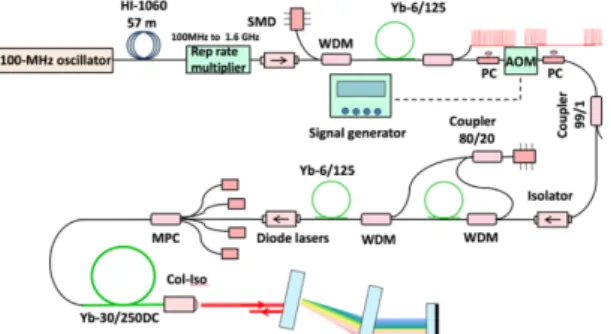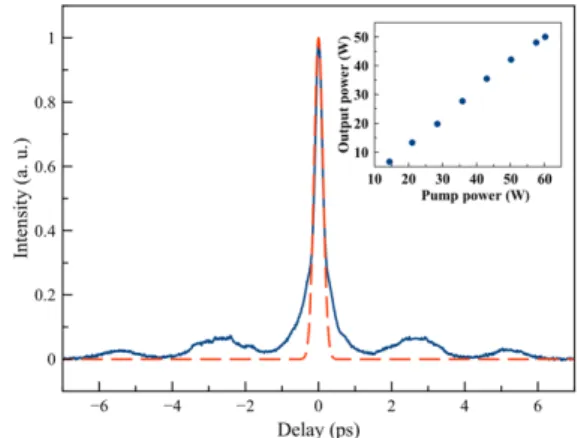Copyright @ IEEE
50-W, 1.6-GHz Pulse Repetition Rate from a
Burst-Mode Yb-Doped Fiber Laser
Parviz Elahi
1, Ayse Cansu Ertek
2, Koray Eken
2, and F. Ömer Ilday
1,3 1Department of Physics, Bilkent University, Ankara, 06800, Turkey2FiberLAST Inc., Ankara, Turkey
3Department of Electrical and Electronics Engineering, Bilkent University, Ankara, 06800, Turkey
Abstract-We report a 50-W average power Yb-doped fiber laser amplifier system. The laser system produces bursts at a minimum rate of 200 kHz, with 1.6 GHz intra-burst repetition rate. The total energy delivers in a intra-burst is 250 µJ and the individual pulse energy is about 0.4 µJ. The output pulses are compressed to 270 fs by using two compressor gratings.
I. INTRODUCTION
Ultra-short fiber lasers operating in the burst-mode have developed more rapidly in the past decade [1,2]. They are drawing much interest due to their significant advantages in material processing, especially in high precision thermal-damage free ablation. In recently- exploited ablation-cooled material removal regime [3], burst of ultra-fast pulses are applied for material processing. In this regime, we use ultrafast successions of laser pulses to ablate the target material before the residual heat, deposited by previous pulses, diffuses away from the processing region [3]. We showed that using of extremely high pulse repetition rates, which make ablation cooling possible, reduce the threshold pulse energy for ablation and increase the efficiency of the removal process by an order of magnitude over previously used laser parameters.
To achieve ablation-cooled material processing, we demonstrate a high-power burst-mode fiber laser system with an average power of 50 W. The intra-burst pulse repetition rate is 1.6 GHz. To minimize amplified spontaneous emission (ASE), the burst repetition rate is adjusted at a minimum rate of 200 kHz [4]. The total energy in each burst is 250 µJ and the individual pulse energy is about 0.4 µJ. By using a compressor grating, the pulse is compressed to 270 fs.
II. EXPERIMENTAL SETUP
The schematic of experimental setup is shown in Fig 1(a). The home-built dispersion–managed oscillator delivers 4-ps long pulses with 100 MHz repetition rate. After a repetition rate multiplier (RRM), comprises of five 50/50 coupler, followed by 57-m long stretch fiber, we achieve 50-ps long pulses at 1.6 GHz. 5 mW output from RRM amplified to 120 mW in the first
amplifier stage. An acousto-optic modulator is employed to generate burst. Acousto-optic modulator is driven by a signal generator to produce desired burst width and burst repetition rate. Second stage amplifier, amplifies output signal from acousto-optic modulator to about 150 mW. The power amplifier is based on 4-m long Yb 30/250-DC with 3.5 dB/4-m cladding absorption at 976 nm. This amplifier stage is pumped by four 25 W diode by a high-power multimode pump-signal combiner (MPC). Thermal and nonlinear effects are the main issues especially in power amplifier stage and have to be managed carefully [5,6]. The output of power amplifier delivers to a high power isolator-collimator and leads to a pair of compressor grating to compress the pulse.
Fig. 1. Schematic of setup. SMD, single mode diode laser; WDM, wavelength division multiplexer; PC, polarization controller; AOM, acousto-optics modulator; MPC, multimode pump-signal combiner; Col-Iso, collimator-isolator.
III. RESULTS
Measured output optical spectra at 50 W is shown in Fig. 2. The burst repetition rate in this measurement is 200 kHz.
Copyright @ IEEE Fig. 2. Measured output spectra at 50 W. Inset: Semi-logarithmic
version.
Fig. 3 Measured intensity autocorrelation (blue solid-line) and fitting by a Gaussian shape (red dashed-line). Inset: Power scaling. and the burst width is 400 ns. Raman effect is not observed in this power level as is shown in this figure. The output from an isolator-collimator then delivers to compressor grating with 1200 line/mm. The achieved pulse width after compressing is about 270 fs. The observed side modulation in the autocorrelation trace is due to birefringent crystal in acoustic optics modulator and can be eliminated by adjusting the input polarization or using polarization maintaining fiber.
IV. CONCLUSION
In conclusion, we built a custom burst-mode fiber laser system, which is optimized for material processing at ultra-high repetition rates. The average power is 50 W, intra-burst repetition rate is 1.6 GHz, and burst repetition rate is 200 kHz. The delivered individual pulse energy is about 400 nJ and could be compressed to 270 fs by using compressor grating.
REFERENCES
[1] P. Elahi, S. Yılmaz, YB. Eldeniz, F. Ö Ilday, “Generation of picosecond pulses directly from a 100 W, burst-mode, doping-managed Yb-doped fiber amplifier,” Opt. lett. 39 (2), 236 (2014). [2] C. Kerse, H. Kalaycıoğlu, P. Elahi, Ö. Akçaalan, F.Ö. Ilday,” 3.5-GHz intra-burst repetition rate ultrafast Yb-doped fiber laser,” Opt. Commun. 366, 404 (2016).
[3] C. Kerse, H. Kalaycıoğlu, P. Elahi, B. Çetin, D. K Kesim, Ö. Akçaalan, S. Yavaş, Mehmet D. Aşık, B. Öktem, H. Hoogland, R. Holzwarth, F. Ö. Ilday, “Ablation-cooled material removal with ultrafast bursts of pulses,” Nature, 537 (7618), 84 (2016).
[4] S. Yılmaz, P. Elahi, H. Kalaycıoğlu, FÖ Ilday, “Amplified spontaneous emission in high-power burst-mode fiber lasers,” JOSA B 32 (12), 2462 (2015).
[5] P. Elahi and N. Zare, “The analytical solution of rate equations in end-pumped fiber lasers with minimum approximation and temperature distribution during the laser operation,” Acta Physica Polonica A, 116 (4), 522 (2009).
[6] P. Elahi, S. Yılmaz, Ö. Akçaalan, H. Kalaycıoğlu, B. Öktem, Ç . Sȩenel, F. Ö. Ilday, K. Eken, “Doping management for high-power
fiber lasers: 100 W, few-picosecond pulse generation from an all-fiber-integrated amplifier,” Opt. Lett. 37 (15), 3042 (2012).

